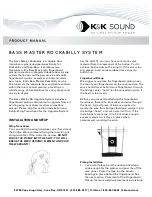
Remote Operation
Manual 31470, Rev. E, April 2001
3-55
Variables
Some commands must include one or more variables to specify quantities or options for the command.
For example, the function code ANALOG (used in commands to configure the analog output) is
combined with several variables to specify different aspects of the analog output. In the command
ANALOG LOG -80.0, 20.0, 0.0, 10.0
the variables are interpreted as follows:
LOG
Specifies that power is to be measured in logarithmic units (that is, dB or dBm).
-80.0
Specifies that the low end of the analog output voltage range represents -80 dBm in.
+20.0
Specifies that the high end of the analog output voltage range repr20 dBm in.
0.00
Specifies that the low end of the analog output range is 0 volts.
10.0
Specifies that the high end of the analog output range is 10 volts.
In the above example, the numeric variables are strung together with separator characters between them
(see
Separators
, below). However, in some commands, numeric variables are preceded in the command
string by the variable name. For example, in the command FBUF PRE TTL BUFFER 200 TIME 1300,
the numeric variables known as buffer and time are identified by name within the string.
Many variables are qualitative rather than quantitative; they select from among the various modes or
options available for a particular function.
Suffixes
Some commands require a terminating suffix. For example, the function code DY specifies a duty cycle.
It requires an AE or BE prefix to identify the sensor, and a numeric variable to indicate the duty cycle as
a percentage. Finally, the command must include a terminating suffix (the choices of suffix in this case
are EN, PCT, and %). The command AE DY 50 % sets the duty cycle for sensor A to 50 percent.
Separators
Spaces, commas, colons, and semicolons can be used as separators between the various elements of a
command (function codes, variables, etc.). For readability, commands in this manual are usually spelled
out with spaces inserted between the elements (for example, SWIFT PRE GET BUFFER 100).
Although separators within a command are permitted, they are usually not required. In the command
descriptions in this chapter (beginning with Section 3.4), required separators are noted.
NOTE:
Some commands that include numeric variables require a terminating suffix while
other commands do not, and interface problems will occur if the suffixes are used in
commands which do not need them. Each command must be used so that its particular
syntax requirements are met.
☛
☛
☛
☛
Summary of Contents for 8650A Series
Page 4: ......
Page 12: ...Series 8650A Universal Power Meters viii Manual 31470 Rev E April 2001 ...
Page 16: ...Series 8650A Universal Power Meters xii Manual 31470 Rev E April 2001 ...
Page 18: ...Series 8650A Universal Power Meters xiv Manual 31470 Rev E April 2001 ...
Page 20: ...Series 8650A Universal Power Meters xvi Manual 31470 Rev E April 2001 ...
Page 32: ...Series 8650A Universal Power Meters 1 12 Manual 31470 Rev E April 2001 ...
Page 198: ...Series 8650A Universal Power Meters 3 124 Manual 31470 Rev E April 2001 ...
Page 216: ...Series 8650A Universal Power Meters A 8 Manual 31470 Rev E April 2001 ...
Page 228: ...Series 8650A Universal Power Meters B 12 Manual 31470 Rev E April 2001 ...
Page 240: ...Series 8650A Universal Power Meters Index 6 Manual 31470 Rev E April 2001 ...
















































